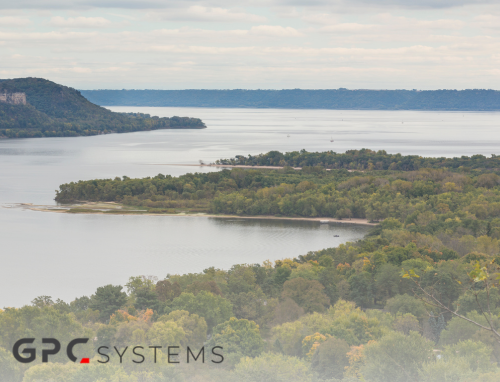
The Mississippi’s Silent Scream: A Logistics Challenge Unfolding
The Mississippi River, a vital artery for American commerce, is facing a crisis that threatens to disrupt the nation’s logistics and agricultural sectors. For the third consecutive year, low water levels are plaguing this crucial waterway, creating a ripple effect that extends far beyond its banks.
In September 2023, the Mississippi River near Memphis reached an alarming low of -10.97 feet, surpassing the previous year’s record. This drop has severe implications for shipping and agriculture, particularly as the harvest season approaches. The timing couldn’t be worse, with farmers preparing to harvest record crops of soya and maize while prices hover near four-year lows.
The impact on shipping has been immediate and severe. The US Coast Guard reported several barges running aground in the crucial stretch between Greenville and Vicksburg. American Commercial Barge Line warned customers to expect delays of up to two days due to “reduced navigable space”. These delays are not just inconveniences; they represent significant economic losses and logistical nightmares for businesses relying on timely shipments.
One stark example of the crisis occurred in October 2022 when the Coast Guard reported a backup of more than 2,000 barges on the Lower Mississippi. This maritime traffic jam stretched for miles, with each day of delay translating into millions in lost revenue and spoilt goods. The situation has only marginally improved in 2023, with similar scenarios threatening to unfold as water levels continue to drop.
The economic impact is staggering. Barge rates have surged by 115% compared to the three-year average, directly affecting transport costs for a wide range of products. In late August 2023, rates for barges from St. Louis, Missouri, were 65% more expensive than the average over the past three years. This increase in shipping costs threatens to erode the competitive edge US exports have long enjoyed in the global market.
Adapting to this new reality is crucial for industries dependent on the Mississippi River. Some companies are exploring alternative transport methods, such as rail or lorry, to move goods to domestic markets. However, these options are often more expensive and less efficient than barge transport.
In regions where options are more limited, innovative solutions are emerging. Some logistics firms are investing in temporary storage facilities near the river, allowing businesses to hold their products until water levels rise. Others are exploring the possibility of smaller, shallower-draft barges that can navigate lower water levels, though this would reduce overall capacity.
The US Army Corps of Engineers has been working tirelessly to maintain the river’s navigability. Dredging operations have been intensified to deepen channels, and rock pinnacle removal projects have been accelerated to eliminate underwater obstacles. These efforts, while helpful, are short-term solutions to a potentially long-term problem.
Looking ahead, long-term solutions are needed to address recurring low water levels. Some experts propose constructing more reservoirs along the river’s tributaries to regulate water flow during dry periods. Others advocate for modernising the lock and dam system to better manage water levels. However, these projects would require significant investment and years to implement.
In the meantime, the logistics industry is adapting by diversifying transport options. Intermodal solutions—combining river, rail, and road transport—are becoming more common as companies seek greater flexibility in their supply chains. Investments in predictive analytics are also on the rise as businesses aim to anticipate river conditions and plan shipments accordingly.
As we navigate these troubled waters, it’s clear that a combination of short-term adaptations and long-term solutions will be necessary. The resilience of American industries and the ingenuity of logistics professionals will be put to the test as they work to ensure that this critical waterway remains a reliable lifeline for commerce in the future.
To conclude, while the low water levels on the Mississippi River pose significant challenges for logistics and transport sectors today, they also present an opportunity for innovation and adaptation moving forward. By embracing new strategies and investing in infrastructure improvements, we can work towards ensuring that this vital artery continues to serve its essential role in American commerce for generations to come. In light of these challenges, innovative solutions like GPC Systems’ Freight Measure software could play a crucial role in optimising logistics operations. This freight dimensioning system can help businesses maximise space utilisation and improve cost-effectiveness, particularly in situations where every inch of cargo space counts.
Freight Measure uses advanced 3D camera technology to accurately calculate the dimensions of freight in just one second, with the ability to measure items ranging from small packets of screws to oversized cargo up to 5 metres in size. This speed and versatility could be invaluable when dealing with the unpredictable conditions of river transport. The system excels at capturing dimensions of highly irregular items, which is particularly useful when dealing with diverse cargo loads. It can operate effectively in low-light conditions, making it suitable for various environments along the supply chain.
By providing accurate measurements quickly, Freight Measure can help eliminate human error in dimensioning, a critical factor when optimising limited cargo space. The software’s ability to integrate with existing systems allows for real-time data communication, enabling better planning and utilisation of available transport capacity.
For businesses facing the challenges of reduced river capacity, such a system could help maximise the use of alternative transport methods by ensuring precise load planning. This could lead to significant improvements in operational efficiency and cost savings, with some logistics customers reporting that the system paid for itself within a 4-week proof of concept period.
As the logistics industry adapts to the ongoing challenges posed by the Mississippi River’s low water levels, tools like Freight Measure could prove instrumental in maintaining efficiency and competitiveness in an increasingly complex transport landscape.

